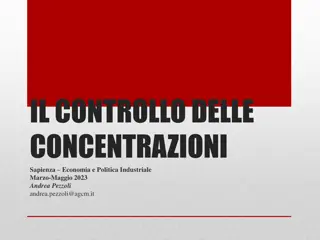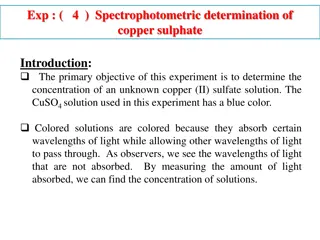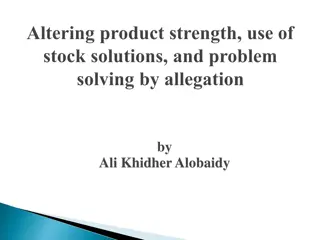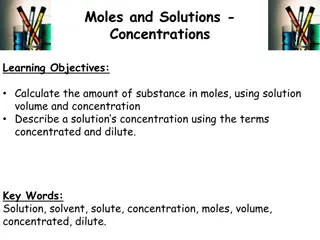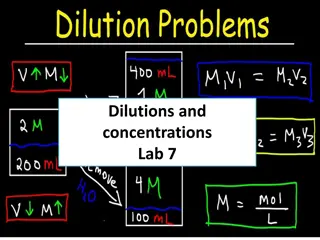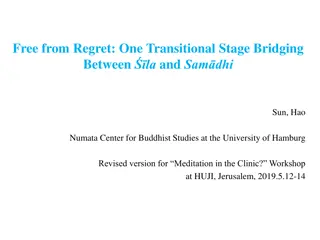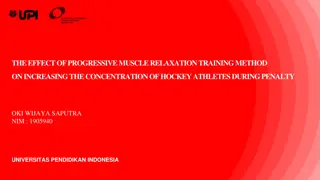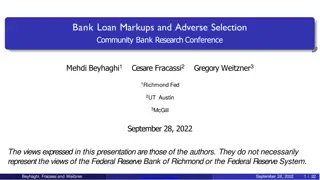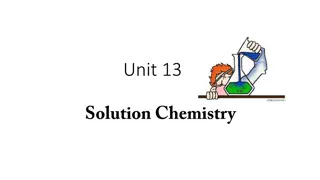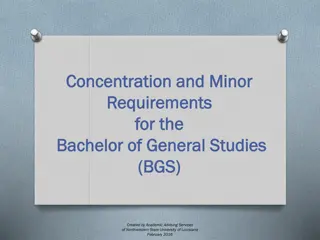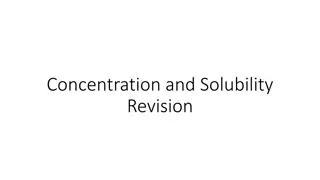Understanding Market Concentration and Its Implications
Market concentration refers to industries controlled by a small number of leading producers, impacting pricing and output decisions. Various theories, measurement methods, and implications on firm behavior and performance are discussed, highlighting the relationship between monopoly power and market concentration.
Download Presentation

Please find below an Image/Link to download the presentation.
The content on the website is provided AS IS for your information and personal use only. It may not be sold, licensed, or shared on other websites without obtaining consent from the author. Download presentation by click this link. If you encounter any issues during the download, it is possible that the publisher has removed the file from their server.
E N D
Presentation Transcript
Unit Three: Market Concentration 3.1 Nature and Theories of Concentration Market concentration refers to the situation in which an industry or a market is controlled by a small number of leading producers who are exclusively or very largely engaged in that industry. Two variables that determinates such situation are: the number and size distribution of firms within the market.
How these two dimensions cause different forms of the market structure having vital consequences for the pricing and output decisions of the firm? The implication of market concentration in industrial economics is far wider than theory of the firm. Market concentration (the degree of sellers' concentration in the market), is an important element of the market structure, which plays a dominant role in determining the behaviour of a firm in the market.
A market is said to be more concentrated, the fewer the number of firms. The "market structure-conduct-performance" requires a means of identifying different market structures: concentration in the ownership of the industry concentration of decision-making power, and concentration of the firms in a particular location or region, etc. All of these elements of market concentration may have considerable impact on the market performance of the firms such as profitability, growth, and technological progress.
3.2 Measuring Market Concentration Measurement of market concentration help us to test empirically the behavioral hypothesis about the firms and industries. Various quantitative suggested for this purpose. Some of them are used to measure the monopoly power and some others for market concentration. indices have been
These two terms are closely interrelated and cannot be separated from each other in the measurement process of market concentration. The measures for monopoly power : It would be more appropriate at firm level. They indicate the actual monopoly power exercised by the firms. The measures of concentration: it would give us the potential monopoly power in the market or industry as a whole. Market concentration is condition for the monopoly power. A market concentration measure should be decreasing as the number of firms in the market keeps on increasing. necessary therefore a
Some of the general conditions that should be satisfied by each one of the indices are: The measure must yield unambiguous ranking of industries by concentration. The concentration measure should be a function of the combined market share of firms rather than the absolute size of the market or industry. If the number of firms increases, then concentration should decrease. However, if the new entrant is large enough, then concentration may go up. If there is transfer of sales from a small firm to a large one in the market, then concentration increases. Proportionate decrease in the market share of all firms reduces the concentration by the same proportion. Merger activities increase the degree of concentration.
It may not be to possible satisfy for all an index the of concentration conditions. There measuring market concentration all of which are not equally good or bad i.e., there is no perfect or the best index monopoly power. A measure of market concentration tries to transform the information on the number, size and distribution of firms concentration curve into a single value. of above are several measures suggested for for concentration or presented on the
3.3 The Concentration Curve and Measures of Market Concentration The Market concentration cumulative market share from the largest to the smallest. It may provide information on the structural characteristics of the market. Graphs between cumulative number of firms from largest to smallest (X-axis) and cumulative percentage of market supply (Y-axis) are shown by points: A, B & C for three industries separately. (See the following graph). Curves plot the
Market A is the highly concentrated industry. For the first five largest firms, market C is more concentrated than B. But, for the number of firms greater than five, market B is more concentrated than C. There are six main measures of concentration. i. Concentration Ratio (Cr): is the most popular and simplest index for measurement of market concentration or monopoly power. It is defined as the share of market held by some of the largest firms in the market.
More specifically, it is defined as a proportion of market share accounted by r largest firms, where r is an arbitrary number. The normal practice is to take r = 4. r r X X = = = + + + i C S S S S S 1 2 3 4 r i = = 1 1 i i
Where Si is the percentage of market share of firm i. The higher the concentration ratio, the greater will be the monopoly power or market concentration existing in the industry. If Cr is close to zero percent, then the largest r firms supply a small share of the market. If Cr is closer to 100%, it implies there high market concentration i.e. the largest r firms supply the largest share of the market. It is possible to calculate the Cr on the basis of value added, total employees, market supply, etc.
Example :We have eight firms in Edible Oil market. The information given in the table below will show us the market share of each firm. Now using the information below, compute the concentration ratio of the higher four firms.
S.N Name of a firm Market share in percentage 1 Firm 1 25 2 Firm 2 1 3 Firm 3 4 4 Firm 4 20 5 Firm 5 3 6 Firm 6 2 7 Firm 7 15 8 Firm 8 30
Now the first thing we do is to identify the four largest firms based on their market share. We will put then in descending order as you can see in the table below. S.N Name of a firm Market share in percentage 1 Firm 8 30 2 Firm 1 25 3 Firm 4 20 4 Firm 7 15 Total 90
Now using the formula given for concentration ratio, we can get the monopoly power of these four firms. The value of the concentration ratio is 0.9 or in other word the four firms took 90 percent of the total market.
Limitation of the concentration ratio This index has two limitations: the arbitrary selection of r and only a single point on the concentration curve is taken without information on the size distribution of the r firms. The Arbitrary Selection of r - when the concentration curves intersect, the measure (Cr) will give different ranking of industries for different values of r . For instance, at Cr3, firm C is more concentrated than B. But at Cr6 market B is more concentrated than market C.
The basic problem with Concentration ratio is that it provides no information about the size distribution of the r firmschosen for constructing the ratio. Suppose in industry A where there are four firms, the largest firm has 97% market share and the other three account for 1% each. In industry B there are four firms each with a market share of 25%. For both industries (A&B) Cr4 = 100% although the market structure is different. That is, market A is more or less a monopoly market.
(ii)The Hirschman-Herfindahl (HHI)Index: Unlike the concentration ratio (Cr), the HHI takes into account all points on the concentration curve. HHI is the sum of the squares of the relative sizes (or market shares) of all firms in the market, where the relative sizes are expressed as proportions of the total size of the market. Mathematically, the HHI index is given by: n = i = 2 HHI i S 1
Where Si = qi/Q, qi is output of ith firm and Q is total output of all the firms in the market, and n is the total number of firms in the industry. The index is close to zero when there is large number of equal sized firms, or equal to one under monopoly. The HHI has two principal advantages: Squaring the individual market shares gives more weight to the shares of the larger firms. It uses information about the market share of all relevant firms.
The HHI gives added weight to the biggest industries. The higher the index, the more the market concentration and (within limits) the less open market competition. Example We have six firms in a given computer market. The following table shows the market share of the firm.
S.N Name of a firm Market share in Square of market share percentage 20 1 Firm 1 0.04 2 Firm 2 15 0.0225 3 Firm 3 10 0.01 4 Firm 4 15 0.0225 5 Firm 5 25 0.0625 6 Firm 6 15 0.0225 Total 0.018
Using the formula above, first you can compute the square of each market share of a given firm. After that just take the summation of the square of each market shares. It will give you the value of the Hirschman Herfindahl index. That is 0.018 the value indicates that monopoly power of the firms is very low.
A Hirschman-Herfindahl index of S12 or 1002, or 10,000. By definition, that is the maximum score. By contrast, an industry with 100 competitors that each has 1% of the market would have a score of 12 + 12 + 12+ ... + 12 or a total of 100. The more typical situation might be a duopoly. If each of the two firms has a market share of 50%, theHirschman-Herfindahl index would be (50)2 + (50)2 = 2500 + 2500 = 5000. With two firms that have of 75% and 25% respectively, theHirschman-Herfindahl index would be: (75)2+ (25)2 = 5,625 + 625 = 6,250 monopoly, for example, would have
In recognition of its advantage, the HHI has been accepted as a measure of concentration in the United State of America, especially as a guideline to decide merger cases. According to the guidelines to decide merger cases un-concentrated markets are defined, as those in which HHI is 1000 or less which is equivalent to 10 equal sized firms. In this situation mergers (at least two firms merged in each other) leading to a rise of HHI = 200 points are challenged or disallowed.
A market is assumed to be concentrated if HHI is 1800 or more which is roughly equivalent to five equal sized firms. Each one has a share of 20%. In this case mergers leading to a 100 point or more rises in HHI are rejected or challenged. When two firms with market share of S1 and S2 merge the HHI increases by 2S1S2. The purpose of disallowing merger is that it may lead to a monopolysituation.
iii. Entropy Index: it is quite recently to measure the degree of market concentration. Market concentrations are weighted by the logarithms of the market shares. It uses the following formula: 0< E < log (n) where EI is defined as 'Entropy coefficient.' 1 P n = log( ) EI P i = 1 i i
It uses the formula where E is defined as Entropy Coefficient, Pi is the market share of ith firm and n the number of firm. This coefficient in fact measures the degree of market uncertainty faced by a firm in relation to a given customer. This will be the situation when number of firms is large enough, i.e., market is not concentrated. For a monopoly firm (n=1) the Entropy coefficient takes the value of zero which means no uncertainty and concentration. maximum there is
Thus, we find inverse relationship between the Entropy coefficient (EI) and the degree of market concentration. If there are n firms, all equal in size, then: 1 log( ) i n = n = = log( ) EI n n 1 EI is similar to HHI, but the difference is that EI gives relatively more weight to the smaller firms. Numerical Example We have six firms in a given Mobile market. The following table shows the market share the firms.
S.N Name of a Market share 1/Pi Log 1/Pi P1(log 1/Pi) firm In Percentage (Pi) 1 Firm 1 20 5 0.7 0.14 2 Firm 2 15 7 0.8 0.12 3 Firm 3 10 10 1 0.1 4 Firm 4 15 7 0.8 0.12 5 Firm 5 25 4 0.6 0.15 6 Firm 6 15 7 0.8 0.12 Total 0.75
iv. The Dispersion method : is an index used to measure equality/ inequality using Gini coefficient (GC). It is used to plot cumulative market share against the cumulative percentage of firms. In this case, firms are cumulated from the smallest to the largest unlike that of the concentration curve. That is, the Gini (or Lorenz curve) shows the variation in cumulative percentage distribution of market share with cumulative distribution of firms from smallest to largest in the market (as shown in figure below).
In figure 3.2, Line OA is line of perfect equality, representing equal sized firms. Curves 2 & 3 represent Lorenz Curve. Greater inequality results if Lorenz curve is farther from line of equality. Curve 3 thus reflects highest inequality. A coefficient which we may call 'Lorenz coefficient' or 'GINI-coefficient' is obtained by dividing the area bounded between the Lorenz curve (say curve-2) and the diagonal line OA { shown with rectangles in it } by the area of the triangle under the diagonal (OAC).
That is, In all case, 0 < GC < 1; greater the magnitude of GC say 0.5, 0.6 or 0.7 higher inequality exists and vice versa. Limitation of Gini coefficient: one basic problem with GC is that it favors equality of market shares without regard to the number of equal sized firms, i.e. GC equal to zero for two firms with 50% market share each or 3 firms with 33.3% market share each, etc. Re ) 1 ( gion = GC OAC ( ) Area
Thus, competition. But this is not always true because the level of competition differs with the number of firms but not equal size firms. Sufficient and accurate data about the market share of every firm in the market may not be available. GC=0 implies equal level of
VI. The Lerner Index (LI): is the bestknown measure of monopoly power. It is expressed as: LI = = The greater the deviation between price & MC, the higher the monopoly power of the firm & the greater the market concentration. LI = 0 for perfect competition (since P=MC). Note that for profit maximization we have the familiar condition MR = MC, and MR = P (1- 1/e). Thus, from these two equations, we get the Lerner index as: Marginal - (P) Price cost (MC) - P MC Price (P) P
By substitution, we have: P LI P = MR P MC P = Where e is the price elasticity of demand and hence, LI is the inverse of e, which is price elasticity of demand. P MC LI P 1 e = = + / P P P e P = = = ( / )/ p e 1/ L p e I
Example: Suppose firms are operating in two markets: Market 1 where Price of the product is 100 birr and marginal cost of production is 25 birr and Market 2 where Price of the product is 50 birr and marginal cost of production is 20 birr Compute Learner index for both Market Which market is more concentrated?
IV. The Elasticity Index The ratio of own elasticity of demand and cross elasticity of demand for a firm could be used as a measure of monopoly power or market concentration in terms of number equivalent i.e. e e ej ji = = 1 ii e or n ii 1 n i
Where eii= own elasticity of demand eji and = cross elasticity of demand. An increase in the ratio means lesser number of firms in the market and a decrease means higher number.
Example The product own elasticity of demand of a commodity was 0.15 and cross demand elasticity of the product was 0.60. The number of the firm in this year was ten. Compute the elasticity index e e e = = 1 ii + ii e or n ii 1 1 n ji = = 0.25 1.25 n This indicates the ratio is very high or the number of firms is very less.
3.4 Concentration and the market performance We know that a firm with substantial monopoly power will tend to: charge higher price produce and sell less output make high rate of profit grow faster than others capable of doing anything it wants in connection with its business such as: R & D, advertisement, etc. If we assume that concentration is appropriate measure of monopoly power, we are then in a position to verify the various propositions of the economic theory which reflects the relationship between concentration and market performance of the firm.
i. Concentration and profit: a firm derives the market power or monopoly power in the situation of concentration. Such a market power, through market conducts activities or directly leads to an increase to profitability of the firm. It is frequently assumed that persistence of high rates of profits over a long period of time is the consequence of high degree of intra-industry concentration. Bain was the first to make empirical study on the relationship between concentration and profit.
He argued that there is strong linkage between the two and hence profit rate can be a measure of concentration. However, there are establishing the correct relationship between concentration and profit as both are subject to ambiguities of measurements. For example, since we do have various measures of concentration, we do not know which one is the best measure of concentration. If one measure of concentration is selected, it may have strong correlation with profit but if another indicator of concentration is used it may have weak correlation with profit. some difficulties in
Further, the measurement of profit is not free from weaknesses. For example, it is often based on accounting data which ignores certain opportunity cost elements that are related to own fund, own building and own entrepreneurial ability. All in all, there is positive relationship between profit rate and degree of market concentration on the basis of theoretical logic, though the very precise estimation of which is yet to come. ? Researchable area????????????????????
ii. Concentration and Price Cost Margins: Price margin is another way to define profitability. It is a short term view of profitability based on current assets and cost figures. Average price cost margin is just a ratio of these two magnitudes. Some empirical studies supported the positive relationship between concentration and price- cost margin. However, some other insignificant relationships between the two variables. ? Need a research. Hence, think over it.??????? studies indicate
iii. Concentration and growth of the firm: there are two different views (streams of thoughts) to explain the actual concentration and growth. First view: a firm with the market power may prefer to maintain its high rates of profits by restricting output and charging high price. If it grows, it has to scarify some profit margin and lower price which may not be in its interest. Moreover, there will be all kinds of government restrictions to stop further growth of the firm. relationship between
Static diseconomies of scale and other bottle necks all adversely affect the growth of such a firm. Thus, we expect thehigher the monopoly power, the lesser may be the growth of the firm. Second view: sees positive relationship between concentration and growth of the firm. To maximize the long term profit, firms may like to grow over time even under market concentration. They may create excess capacity to meet the future growing demand and to discourage new entry in the market. For these firms may sacrifice some profit to stimulate long term growth. Thus, we find a case for positive relationship between initial market concentration and growth of the firm.
iv. Concentration and Technological Progress we know thatfew firms that enjoy monopoly power in concentrated industries will be large enough. They will be having stability, financial resource and ability to initiate the process of R& D and again the benefit from them. Some recent researches show the situation when the market is concentrated and innovative activities are positively correlated. However, there is no conclusive empirical evidence to prove such proposition. ???? You call for research???????????
Some argue that it may not be the concentration but the other attributes of market structure like the size of the firm, product differentiation possibilities that may be having collinearity with concentration and thus causing a spurious positive correlation between concentration and technological change. Nothing can be said in either way about the relationship. It is open for further empirical verification. Ditto??????????????????


